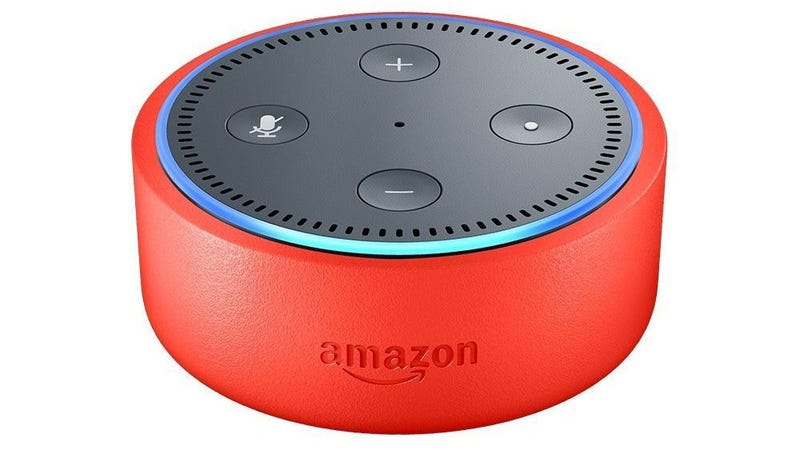
Photo: Amazon
Since my preschooler’s internal clock has still not gotten the memo that on weekends, we sleep in, my husband and I usually let her watch TV or play on the iPad as we slowly peel ourselves out of bed. While her screen time is limited on weekdays, it spikes on Saturday and Sunday mornings, which I don’t always love because it somehow sets a mildly cranky mood for the day. This time, though, when she pranced into our room at 7 am, I took her hand and walked her over to the red, hockey-puck-sized device waiting for us near the kitchen table. “We’re hanging out with Alexa today,” I told her.
Specifically, we were testing out the new children’s version of Alexa, Amazon’s voice-controlled digital assistant. It dwells in the Echo Dot Kids Edition, which launched this month. Revamped for younger ears, this Alexa is “a kid-friendly DJ, comedian, and storyteller” that can read stories, play music, tell jokes, answer questions and remind little Otis that it’s time to start putting on his pajamas. Some are calling it a “digital nanny.” I prefer to see it more as a cheery, always-available cruise director.
“Alexa, good morning,” my daughter greeted it.
“Good morning,” it responded. “You know what my favorite thing to say in the morning is? ‘Cheerio’ because it’s a way of saying hello and it’s a type of cereal. How silly.”
The tone of the kids’ Alexa seems chirpier and generally more optimistic than the sometimes-sassy original Alexa—Kurt Biedler, the director of kids and family for Amazon, tells me the team consulted with childhood experts in creating a language that’s age-appropriate and helpful. When responding to fact-based questions, it infuses a little personality.
“Alexa, how far is the moon?” we asked.
It answered. “The moon’s distance from earth is 239,000 miles or 384,000 kilometers. Wowza! That moon-jumping cow must have strong legs.”
When playing with Alexa, we started without a cheat sheet, simply asking it to “play a game,” “read a story” and “tell a joke.” And we quickly felt a little stuck. The default games for little kids, including freeze dancer and Simon Says, are cute, but mechanic—you might try them as a party trick when friends come over, but that’s about it. Just like with the original Alexa, you really have to know what you’re looking for to get the most value. Parents should check out these downloadable posters, which gives you specific activities to ask for, based on the child’s age. For instance, No Way That’s True is an energetic trivia game by Nickelodeon. Disney Stories includes audio stories about Elsa, Minnie, and other characters. And Name That Animal from National Geographic Kids gives you clues about different animals as you try to guess what animal it is. My husband kept playing this game long after everyone else had left the room—“I’m so good at this!” he boasted to no one.
My daughter listened to audiobooks as she painted at the kitchen table—Clifford The Big Red Dog, Velveteen Rabbit, Pig Pig Grows Up and Pinkerton Behave. The fact that the Dot gives you access to more than 300 children’s Audible books as part of the free year of FreeTime Unlimited is a big seller for me—we love audiobooks and can breeze through several a day.
What I was most impressed with, though, were the choose-your-own-adventure-type audio experiences. After exploring a couple of them—You and the Beanstalk and Loud House Challenge—I’m in awe of the potential this medium has for immersing kids in stories. In these skills, they interact with characters and affect how events unfold. In You and the Beanstalk, co-produced by Earplay and WBUR, kids “climb the Beanstalk” as the main character and make decisions along the way. (“Will you walk to the castle, to the farm or follow music from a pond?”) Narrated by Rebecca Sheir—the creator of Circle Round, one of my favorite kids’ podcasts—the story merges music and sound effects and is just beautifully done.
Loud House Challenge from Nickelodeon, which is geared for older kids, is just as interactive—kids must help the main character Lincoln get through tough situations by solving increasingly difficult puzzles given by all ten of his sisters. I like that these stories are stimulating, encouraging young listeners to pay attention to the smallest details.
Three hours after playing with the Echo Dot Kids Edition, I realized we hadn’t looked at a screen once. That, to me, is promising.
Do I think kids need their own personal AI assistant? Of course not. Am I wary of smart devices targeted at young users, in terms of both privacy and children’s growing dependence on them? Always. But I’m always looking for ways parents can experience digital media with their kids. I’m cautiously excited to see where creators and storytellers take this new technology.

